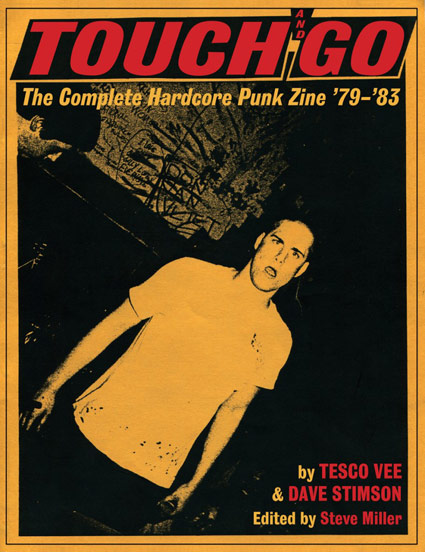
The Complete Hardcore Punk Zine ’79–’83
Bazillion Points
Like many things, the Touch and Go zine was born from a need. Living in the relatively remote, near culturally bereft East Lansing, Michigan in the late ’70s, Tesco Vee and Dave Stimson thirsted for something more than what was being offered to them by middle America radio and mall-based record store chains. Scouring the area within a 200-mile radius for the punk and post-punk records they craved from the West Coast and UK, as well as digesting every copy of Slash, Search and Destroy, Melody Maker, NME and Sounds they could get their hands on, the two determinedly fed their hungers. Getting together in their late-20s—when Vee was working as an elementary school teacher and Stimson had moved back in with his parents for the second time—they opted to spread the gospel, however humble a form that effort might take.
Indeed, the first issue of Touch and Go was just 14 pages. They distributed the 100 copies (Xeroxed covertly at Tesco’s place of employment) to local haunts like record store Flat, Black & Circular. Even though Vee now wonders to whom they might have speaking, that first issue nonetheless exhibited an acerbic wit in dissecting the things they disdained and a well reasoned passion for the music they loved. But as recollected by such peers as Ian MacKaye and (editor) Steve Miller, by issue two, which featured the Avengers’ Penelope Houston on the cover, they were already finding their audience at home and elsewhere. In those pre-internet days, the T&G guys’ dissemination of the records going largely ignored by the music industry and public at large was invaluable. Like the inroads being made by touring bands like Black Flag and REM, Touch and Go helped connect the pockets of discerning ears across the country. In turn, bands they championed like the Misfits and 999 eventually made their way to Lansing.
Bazillion Points has done the world the great service of collecting Touch and Go’s entire four-year, 23-issue run in a handsome paperback. The zine eventually expanded from its ininital 14-page format to include other writers and interviews, and even ended up printing color covers towards the end. Through it all, Vee and Stimson never wavered from their irascible bent, and now it’s been preserved in these 570-odd pages. Though rendered with DIY technique, T&G never applied the kind of dogmatic blinders of, say, Maximumrocknroll, instead never hesitating to sing the praises of any band they found boundary pushing and/or simply appealing. (U2’s Boy gets a thumbs-up.) They also had a penchant for a little bathroom humor, which seems extreme by today’s PC punk standards, but somehow also incredibly cheeky.
Anyway, Tesco eventually moved to DC where he started the Meatmen while also putting out Touch and Go’s last four issues. Before he left, though, he had started the Touch and Go record label with the Necros’ Corey Rusk, who would run the company for more than 25 years after Vee eventually left it in his capable hands. While the legacy of of the label, which scaled back its operations dramatically last year, has overshadowed the zine, for the four years of its existence, Touch and Go was the documentation of all that mattered in music, uninfluenced by anything other than its publishers’ own inclinations.
Stephen Slaybaugh
The World Cup Top 10
Five Hundred 45s
Jello Biafra and the Guantanamo School of Medicine and Chrome Cranks Live Reviews
David Cross, Bigger and Blackerer
Rock 'n' Roll High School
Beach House Live Review
I Need That Record!
The Specials Live Review
The Antlers Live Review
Girls and the Wedding Present Live Reviews
The Big Pink and A Place to Bury Strangers Live Review
Jello Biafra and the Guantanamo School of Medicine and Joanna Newsom Live Reviews
SXSW 2010 Recap
Blank Generation
